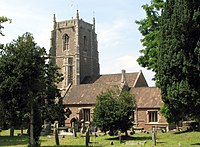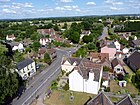| Main | Births etc |
|---|
| Iron Acton | |
 Looking west down High Street from the tower of St. James the Less parish church |
|
| Population | 1,253 (2001 census)[1] |
|---|---|
| OS grid reference | |
| Parish | Iron Acton |
| Unitary authority | South Gloucestershire |
| Ceremonial county | Gloucestershire |
| Region | South West |
| Country | England |
| Sovereign state | United Kingdom |
| Post town | Bristol |
| Postcode district | BS36 |
| Dialling code | 01454 |
| Police | Avon and Somerset |
| Fire | Avon |
| Ambulance | Great Western |
| EU Parliament | South West England |
| UK Parliament | Thornbury and Yate |
| Website | IronActonParish.info |
| List of places: UK • England • Gloucestershire | |
Iron Acton is a village and civil parish in South Gloucestershire, England. The village is about 2 miles (3 km) west of Yate and about 9 miles (14 km) northeast of the centre of Bristol. The B4058 road used to pass through the village but now by-passes it just to the north.
The "iron" part of the toponym originates from the iron that used to be mined near the village. "Acton" is derived from the Old English for "farm (or village)[2] with oak trees". Still today there is an oak wood in the village beside the River Frome.
The civil parish also includes the smaller villages of Latteridge and Engine Common.
Manors[]
Acton Court on Latteridge Lane is a restored Tudor manor house. In the 16th century, Nicholas Poyntz added the east wing to the existing moated house. The addition was lavishly decorated to impress Henry VIII. The king and his second wife, Anne Boleyn, visited the house in 1535 during a tour of the West Country.
Algars Court or Algars Manor, just south of the village, is also a Tudor house.[3]
Parish church[]

Parish church of St James the Less
19th-century engraving of Parish church of St James the Less. The preaching cross, of which then only the base survived, erected by Sir Robert Poyntz, is shown in the churchyard, centre
The Church of England parish church of Saint James the Less is Perpendicular Gothic and includes a clerestory, south aisle and south chapel, two-storey north porch and three-stage bell-tower.[4] The nave and south arcade are of three bays.[4] The nave, chancel and south chapel all have wagon roofs and there is a fan vault under the tower.[4]
The church was restored in 1878–79 under the direction of the Gothic Revival architect Sir T.G. Jackson.[4] The high altar has a reredos designed by F.C. Eden and made in about 1930.[4] Behind the altar of the south chapel is a screen also designed by Eden.[4]
Poyntz Chapel[]
Arms of Poyntz: Quarterly 1st & 4th, barry of eight or and gules (Poyntz); 2nd & 3rd, quarterly per fess indented argent and azure (Acton). The escutcheon, suspended by the guige strap from an initial letter "T", is shown on a field of oak leaves, a reference to the etymology of the ancient settlement of Acton ("Oak-town")

View eastwards along the south aisle towards the Poyntz Chapel. High on the east wall to the right of the window can be seen hanging the funeral helm with spur and piece of leather surcoat borne on the funeral bier of Sir John Poyntz(d.1680)[5]

Canopied tomb against south wall of Poyntz Chapel

Effigies believed to represent Sir John Poyntz(d.1376), son of Matilda Acton, and his wife Elizabeth Clanvow, daughter of Philip Clanvow
Tombstones of Sir Robert Poyntz(d.1439) and his 1st wife Anne. From Samuel Lysons' "Collection of Gloucestershire Antiquities", 1803
Preaching cross, Iron Acton churchyard, erected by Sir Robert Poyntz(d.1439). From Samuel Lysons' "Collection of Gloucestershire Antiquities", 1803
The altar at the east end of the south aisle forms the focal point of the so-called Poyntz Chapel, which is not a separate chamber or structure. This is not to be confused with the Poyntz Chapel (formally termed "Chapel of Jesus") built by Sir Robert Poyntz(d.1520) within The Gaunt's Chapel, Bristol. Against the south wall is a 16th-century canopied tomb erected for a now unknown member of the Poyntz family. Of the three heraldic escutcheons comprised within the structure two are now blank and one bears the arms of the Acton family, from which the Poyntz's inherited the manor, A fess indented. No inscription survives. The tomb was covered with many layers of whitewash until this was removed in the 19th-century restoration. Marking-off the Poyntz Chapel from the chancel is a pair of stone effigies set on slabs at floor level. The figures show an armed knight of the 14th century beside a female figure, possibly his lady, but perhaps of a slightly later date. The knight is believed to represent Sir John Poyntz(d.1376), son of Sir Nicholas Poyntz(d.1311) feudal baron of Curry Mallet,[6] Somerset, by Matilda Acton, his 2nd wife, daughter and eventual heiress of Sir John Acton(d.1312) of Iron Acton.[7][8] Buried beneath an incised slab set into the floor in the centre of the Poyntz Chapel is Robert Poyntz(1359–1439) between his two wives, 1st, Ann (family unknown), 2nd (marr. pre. 1389) Katherine FitzNichol, daughter of Sir Thomas FitzNichol of Hill, Gloucestershire, many times MP for Gloucestershire. Robert was MP for Gloucestershire in 1415 and 1417 and Sheriff of Gloucestershire 1396-7. He was steward between 1405–1416 of the estates of Anne of Gloucester(d.1438), dowager Countess of Stafford in Glos., Hants., and Wilts. and by 1439 was steward of the manor of her son Humphrey Stafford, 6th Earl of Stafford(d.1460) at Thornbury Castle.[9] Robert's slab depicts a knight, almost life-size, wearing a helmet with the body in plate armour with a skirt of traces. He wears a gorget with slight traces of chain-mail, round shoulder pieces, brasserts on the arms, gauntlets with pointed cuffs, legs in plate. His feet rest on a dog.[10] The slab is much worn and was broken in two places in the 19th century. The ledger line contains the following inscription: Here lyeth Roberd poyntz Lord of Iren Acton and thys stepyl maked who deyde the fiftene day of Junne the year of oure Lord MCCCCXX...(last XIX worn away) of whos sowle God have mercy Amen.[11] The church lacks a steeple today, and none is shown in a 19th-century engraving of the church. The church tower itself appears to date from before the time of Robert, so surely cannot have been "the stepyl" referred to. It is however widely accepted that Robert erected the stone preaching cross in the church yard, which displays escutcheons bearing the arms of Acton and FitzNichol, the latter being the family of his second wife. The second slab is incised with the following words within a ledger line: Here lyeth Anne the firste wife of Roberd Poyntz of whos sowle God have mercy Amen. In the centre is shown a life-sized lady wearing a dress with tight-fitting body, low in the neck, laced from hands to waist with tight sleeves, full skirt and reticulated head-dress.[12] The third slab retains only part of a female figure with a ledger line containing the words: ...erine the second wyfe of Robert Poyntz. The slab was re-incised with a Latin inscription to commemorate Elizabeth Poyntz(d.1631), wife of a much later Robert Poyntz. Two other tombstones commemorate Florence Poyntz(d.1598) and Hugh Poyntz(d.1604), son of Sir Nicholas Poyntz(d.1585/6) by Margaret Stanley, daughter of Edward Stanley, 3rd Earl of Derby.[13]
Railway[]
The Midland Railway opened its Thornbury Branch Line in 1872, including Iron Acton railway station to serve the village. The LMS closed the station in 1944 and it was demolished in the 1960s, but the line still carries one freight train per week between a stone quarry at Tytherington and the junction at Yate with the Birmingham and Gloucester line.
A freight-only branch serving an iron mine in Frampton Cotterell joined the branch line at the station. This was closed in 1872 but a truncated section of the line served as a coal depot until closure on 10 June 1963.
Iron Acton station had a single platform and a large wooden station building. The remains of the platform survive, as does a crossing-keeper's cottage to the south of the station site.
Amenities[]
Iron Acton hosts events throughout the year, including the annual May Day fair and horticultural show. Other events are organised by Acton Aid, a community organisation made up of men of the village who work together to benefit the parish of Iron Acton. Money is raised by holding social events such as the annual fireworks display and the Proms in the Meadows, and working with other parish organisations at the annual May Day fair. An example of such an event is the Victorian evening, during which local residents dressed up in Victorian era clothing for a fair on the street, which is accompanied by a brass band.
The village has its own football club, which played home games on the field behind the Rose and Crown public house on the High Street. The pub was closed and was turned into residential accommodation; Iron Acton F.C. now plays home games on Yate Common, Sunnyside Lane, Yate, 1.5 miles (2.4 km) away.
 Iron Acton Primary School (above the orange wires), seen from the tower of the church |
 Looking east along the High Street, seen from tower of the church |
Bibliography[]
- Maclean, Sir John, Historical and Genealogical Memoir of the Family of Poyntz, Exeter, 1885
Sources[]
- Blair, Peter Hunter (1977) [1956]. An Introduction to Anglo-Saxon England (2nd ed.). Cambridge & London: Cambridge University Press. pp. 258–259. ISBN 0-521-29219-0.
- Verey, David (1970). Gloucestershire: The Vale and the Forest of Dean. The Buildings of England. 2. Harmondsworth: Penguin Books. pp. 276–278.
- Thompson, H.L., The Poyntz Family, Transactions of the Bristol and Gloucestershire Archaeological Society, 1879–80, Vol. 4, pp.73–85
External links[]
References[]
- ^ "Area selected: South Gloucestershire (Unitary Authority)". Neighbourhood Statistics: Full Dataset View. Office for National Statistics. http://neighbourhood.statistics.gov.uk/dissemination/viewFullDataset.do;jsessionid=ac1f930b30d5ca6fc801f9564b0390b1c5c74b5b9ab4?instanceSelection=03070&productId=779&$ph=60_61&datasetInstanceId=3070&startColumn=1&numberOfColumns=4&containerAreaId=790298. Retrieved 19 May 2011.
- ^ Blair, 1977, pages 258–259
- ^ Verey, 1970, page 278
- ^ a b c d e f Verey, 1970, page 276
- ^ Text quoted from framed notice in church
- ^ Known by ancient spelling "Cory Mallett" in most genealogies of the Poyntz family
- ^ Church booklet "Iron Acton", no author or date stated, dedicated to Mrs Eileen Meredith(d.1978), pp.3–4
- ^ Heraldic Visitation of Gloucestershire 1623, pp.130–135, pedigree of Poyntz
- ^ History of Parliament biog. p.132
- ^ Description from church booklet, p.4
- ^ The date stated in the published source (Church guide, Iron Acton Church) is thus 1420, yet his biographers give the date of 1439, adding the worn away final XIX i.e. History of Parliament biography, pp.132–134
- ^ Description quoted from church booklet
- ^ Visit of Glos., p.135
| |||||
| This page uses content from the English language Wikipedia. The original content was at Iron Acton. The list of authors can be seen in the page history. As with this Familypedia wiki, the content of Wikipedia is available under the Creative Commons License. |

